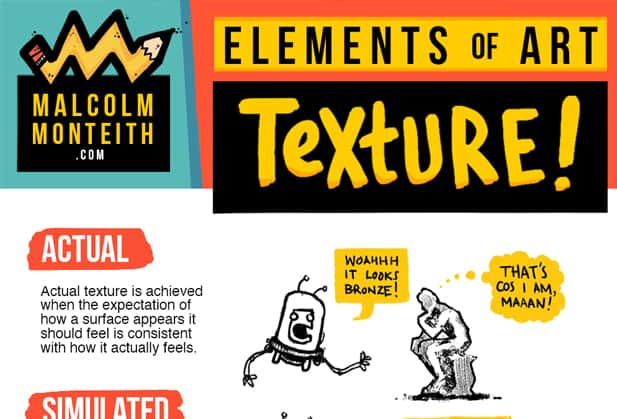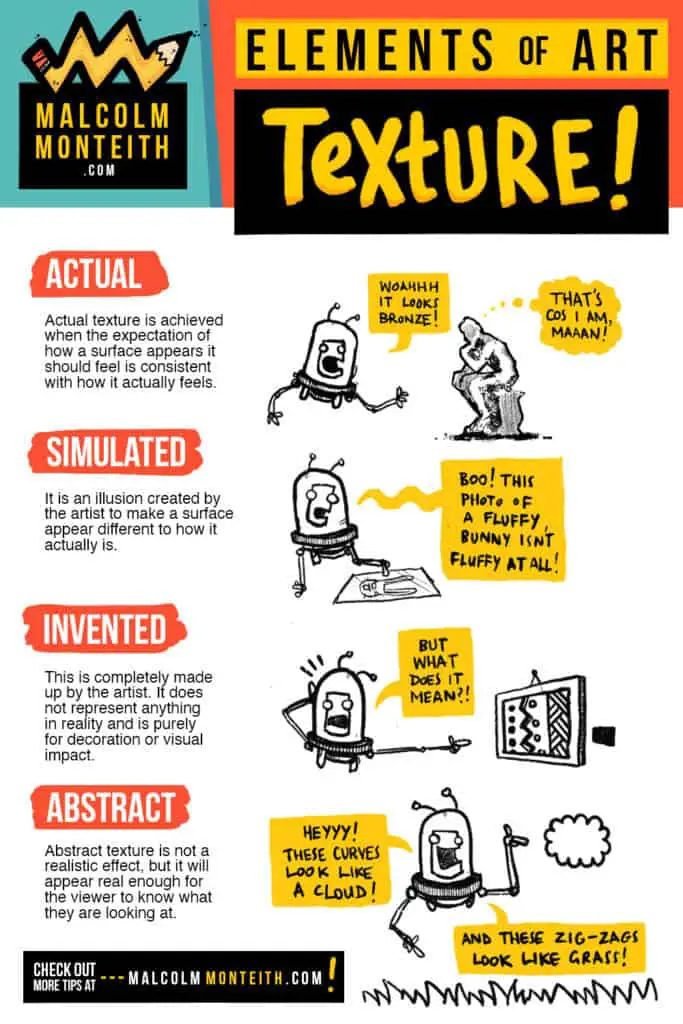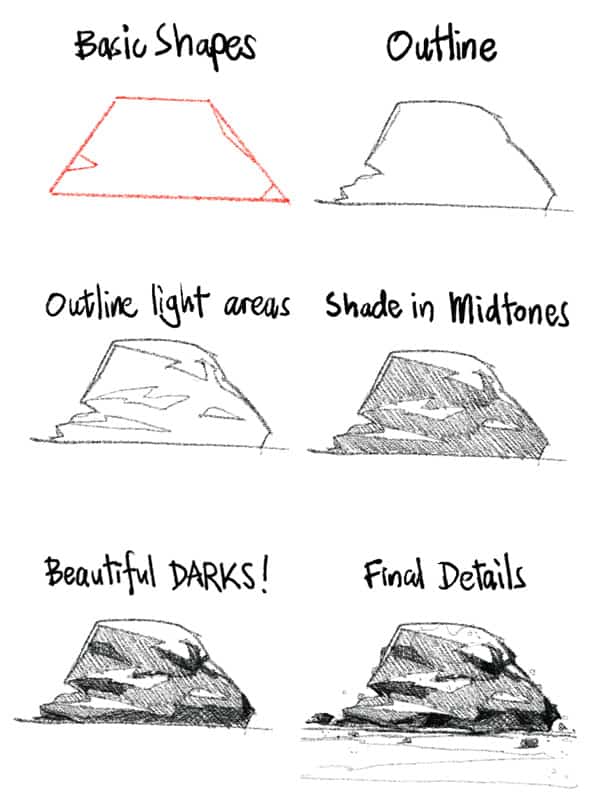Texture is one of the seven elements of art. Texture can be used in different ways to make an artwork look interesting, three dimensional, or just plain cool. Does the artwork look the same way it feels? Has the artwork got an interesting pattern repeated throughout it? All these effects that you can see and touch are known as textures.
Texture is the physical feeling and visual appearance of an artwork. It can be used in different ways to influence an artwork’s tactile properties or to create an illusion by making an artwork appear different to how it feels. Texture can also be used to create abstract patterns to enhance an artwork’s visual appearance.
In this article, we will discuss the different types of texture found in art. we will start with the definition for each of these texture types (followed by some examples). Then, we’ll take a look at ways that we can use texture in our own artworks!
What are the Types of Texture in Art?
The four types of texture in art are:
- Actual texture
- Simulated texture
- Abstract texture
- Invented texture
Actual Texture
Actual texture is the genuine, physical texture of an artwork’s surface. Actual texture is achieved when the expectation of how a surface appears it should feel is consistent with how it actually feels.
Examples of actual texture are:
- The rough surface of a stone sculpture. If you reach forward to touch the surface, it will actually feel rough. Just as you expected!
- The smooth surface of a finely glazed acrylic painting. If you run your (very clean) fingers on it, it will feel smooth.
- The irregular appearance of a thick, buttery oil painting. The paint catches light at different angles of the painting. If you feel the painting, some areas are thicker than others, with brushstrokes in a variety of directions. This is consistent with how the painting appears.
Simulated Texture
Simulated texture is a when an artwork’s appearance looks different to how it feels. It is an illusion created by the artist to make a surface appear different to how it actually is.
Examples of simulated texture are:
- A hyper realistic drawing of a dead leaf. It looks so brittle and crunchy, but when you go to touch it, you only feel the smooth surface of the paper. (You also hear a voice behind you saying “Don’t touch the artwork!”)
- A photograph of a cute, fluffy puppy. You reach out to pet him (cos he’s a good boy!), but no matter how much you stroke the photo, all you feel is a smooth, flat surface.
Abstract Texture
Abstract texture is an artist’s simplified representation of a real texture. Abstract texture is not a realistic effect, but it will appear real enough for the viewer to know what they are looking at.
Examples of abstract texture are:
- A cartoon drawing of a shiny, red balloon. The balloon itself has just a flat, red color, with a shiny reflection added near the top of it (to give that red surface a shiny, smooth texture!). There are enough visual cues to tell the viewer that they are looking at a balloon. But at the same time, it is abstract enough so that nobody would ever think that the balloon is real.
- A drawing of a fishing line in a pond. There are ripples emanating from where the line entered the water. The viewer can see that the fisherman has disturbed the calm water with his deep love for fishing. But the viewer also knows that those ripples are just concentric circles that have been drawn with a pen.
Invented Texture
Invented texture is a texture on an artwork that has been completely made up by the artist. It does not represent anything in reality and is purely for decoration or visual impact.
Examples of invented texture are:
- An abstract painting of an orange square with blue dots scattered all over it. What does this orange square represent? What do those blue dots mean?! We may never know! But it looks cool.
- A drawing of small arrows, joined together to make a tessellation. Each alternating row is colored black. This tessellation has created a texture with no particular meaning, but is visually appealing and interesting to look at.
So far we have discussed the four types of texture in art. Next up we’re going to look at some easy ways to incorporate texture into your artworks…
How to Create Texture with Pencil
If you are wanting to create realistic texture using pencil, you will need to have a plan first!
- For example, if you are wanting to draw a textured rock, you will need to start with the basic shapes. Once you are happy with the overall shape, you can move onto the details.
- Identify the light areas and dark areas. Outline the areas which will be in shadow.
- Lightly shade in your dark areas, leaving your highlights white. Then go over the darkest areas with darker shades.
- Finally, pencil in little bits of detail.
How to Create Texture on Canvas (or any surface!)
Texture is a very important part of painting. It adds depth and interest to an otherwise flat surface. The physical properties of paint allow the artist to incorporate texture into their work using several methods.
Building up your canvas with paint (or a medium) is a type of actual texture. The three dimensional effect the viewer sees is because of the thickly applied paint. If they were to actually feel the painting, it would be consistent with the way it looks.
In this section, we’ll first talk about adding texture with pure paint (this technique is called Impasto painting). Then we’ll talk a bit about adding texture to the surface before you start painting (this is done by applying a textured medium to your surface).
What is Impasto Painting?
Impasto painting is mainly used by oil and acrylic painters. I would not recommend trying it with watercolor or gouache – you won’t get the same effect and you’ll just end up wasting your paint.
Impasto painting can be achieved by applying thick layers of paint to your painting. This can be done in many ways, for example: by using a paintbrush, a palette knife, or applying paint straight outta the tube!
Thick paint that is applied with a paintbrush, will give the painting brushstroke textures.
If you really want to go nuts with the layering, swap out your paintbrush for a palette knife for some guaranteed maximum texture!
This is because palette knives are metal, and therefore they will have minimum excess paint left on them. Whereas with a paint brush, there will always be paint stuck left on the bristles.
The good thing about palette knives is that they are also great for mixing colors. So you can get the color you want before applying it to your painting.
Or! If you just want to add the pure, unmixed pigment to your painting, you can always skip the tools and just squeeze it onto your painting, straight from the tube.
In summary, impasto painting adds texture to an artwork. This can be applied with a brush, palette knife, straight from the tube… actually you can use just about any object, so feel free to get creative.
So we’ve talked about adding texture with paint, now let’s discuss adding texture before the painting! (this is done using a textured medium).
Adding a Textured Medium to Your Surface
Before you start a painting, adding a textured medium can create a foundation for some fantastic textured effects.
Textured mediums are often acrylic based, which means you can use them as your base for either acrylic or oil painting. (But just make sure you don’t put textured medium on top of an oil painting, otherwise you’ll get some very impressive cracks!)
Check your local art store or website to see the different types of mediums, but personally I use one called Atelier modelling compound.
Similar to impasto painting, you can apply a textured medium with a paintbrush, palette knife, elbow, chair, fork – whatever you have around you that you don’t mind getting a bit messy.
This is a purely creative process! You don’t need to worry about color, shape or form. All you are doing here is creating interesting effects on your canvas with actual texture that will show through once you apply your paint over it.
When you are happy with the texture you have created, let it dry completely. Once it’s dry, you’ll then be ready to start painting.
Conclusion!
So there ya have it. There are four different types of texture, all with very important roles to play in helping art look fantastic!
- Actual texture helps to give an artwork its physical structure.
- Simulated texture is used to create the illusion of something that isn’t actually there.
- Abstract texture is a simplified way of representing something real.
- Invented texture doesn’t represent anything in reality, but is great for enhancing an artwork’s visual appeal.
Texture can be added to an artwork in different ways including (but not limited to)
- Creating an illusion with pencil on paper, using lines and shading.
- Impasto painting on a canvas using a paintbrush, palette knife or straight from the tube
- Using Texture medium to build up texture on a canvas before you begin painting
Without texture, we would be left with far less interesting art in the world. So grab some art supplies and have some fun exploring your own ways to create texture!
All the best!
Malcolm
Related Articles
Thank you for stopping by to learn about texture! Check out more of the Elements of Art right here:




2 thoughts on “Elements of Art – Texture (And How to Give Your Art Feeling!)”